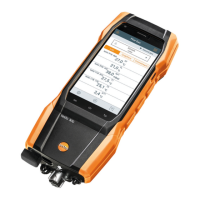
Do you have a question about the TESTO 300 LL NEXT LEVEL and is the answer not in the manual?
| NO2 measurement range | 0 to 500 ppm |
|---|---|
| Resolution CO | 1 ppm |
| Resolution NO | 1 ppm |
| Resolution NO2 | 1 ppm |
| Resolution SO2 | 1 ppm |
| Protection class | IP40 |
| Product Type | Flue Gas Analyzer |
| CO measurement range | 0 to 4000 ppm |
| Measurement parameters | O2, CO, NO, NO2, SO2, H2S, CxHy, Temperature, Draft, CO2 |
| Accuracy CO | \u00b15 ppm or \u00b15% of reading |
| Accuracy NO | \u00b15 ppm or \u00b15% of reading |
| Accuracy NO2 | \u00b15 ppm or \u00b15% of reading |
| Accuracy O2 | \u00b10.2 % O2 |
| Resolution CO2 | 0.1 % Vol. |
| Resolution O2 | 0.1 % O2 |
| Storage temperature | -20 to +50 °C |
| Battery life | Approx. 10 hours |
| Connectivity | Bluetooth |
| Temperature measurement range | -4 to +2192 °F / -20 to +1200 °C |
| Accuracy H2S | ±5 ppm or ±5% of reading |
Displays and their explanations for basic information and actions.
Explains warning pictograms like DANGER, WARNING, CAUTION.
Identifies and explains the components on the front of the instrument.
Identifies and explains the components on the rear of the instrument.
Details the various connection ports on the instrument.
Guidance on the initial commissioning process for the instrument.
Information on powering the instrument using mains or battery.
Instructions for charging the instrument's internal battery.
How to operate the instrument using the mains adapter.
Explains how to interact with the instrument via its touchscreen.
How to use the instrument's keypad for input.
Procedures for powering the instrument on, off, and standby.
Instructions for connecting flue gas probes and temperature adapters.
Guide to connecting wireless probes and the testo Smart App.
How to connect the Bluetooth connector for wireless communication.
Steps to establish a connection with the testo Smart App.
Overview of the testo Smart App's user interface elements.
Initial setup steps for connecting the testo 300 to the Smart App.
How to perform measurements using the testo Smart App.
Explanation of the instrument's main user interface elements.
How to configure and use the list view for readings.
How to configure and use the graphics view for readings.
How to use the corestream display for temperature measurements.
Description of the main menu structure and its options.
Managing customer and measuring site information.
Accessing, managing, and sending measurement protocols.
How to open, send, and delete saved measurement reports.
Activating/deactivating the Smart App connection.
Performing regular leak checks on the measurement system.
Configuring various instrument settings.
Setting the instrument's country version and language.
Setting up a connection to a Wireless LAN.
Setting the instrument's date, time, and time zone.
Setting up and managing email accounts for sending reports.
Protecting CO/NO sensors against overload.
Setting alarm limits for CO Ambient measurement.
Checking the status and condition of the instrument's sensors.
Viewing a list of instrument errors.
Accessing detailed information about the instrument.
Setting up and using e-mail accounts for sending reports.
Steps for updating the instrument's firmware via USB.
Steps to prepare the instrument and probes before measurement.
Procedures for zeroing gas sensors and pressure sensors.
How to perform a gas path check for system leaks.
Instructions for correctly using and aligning the flue gas probe.
Lists and briefly describes available measurement types.
Detailed guide for performing flue gas measurements.
Instructions for performing draught measurements.
Guide for measurements according to the 1st BImSchV standard.
Guide for measurements according to the 44th BImSchV standard.
Instructions for performing measurements on solid fuel systems.
Performing measurements of undiluted carbon monoxide.
Performing differential pressure measurements.
Performing differential temperature measurements.
Calculating gas flow and burner capacity.
Calculating oil flow rate and burner capacity.
Performing tightness test 1 for pipes.
Testing the serviceability of gas pipe systems.
Performing a 'Let by' test.
Performing a 4 Pa measurement.
Overview of available options like view editing and averaging.
Customizing the display of measurement parameters and units.
Manually zeroing the gas sensors.
Setting up mean value calculation for measurements.
Overview of features related to measurement protocols.
Printing measurement readings via Bluetooth.
Saving measurement data on the instrument.
Finalizing and preparing measurement reports.
Recommendations for annual service checks by authorized centers.
Information about calibration protocols and recommendations.
How to check the status of sensors and error lists.
Displaying and interpreting sensor status.
Viewing a list of instrument errors.
How to clean the instrument's housing and analyzer.
Procedures for draining the condensate container.
Steps for safely opening the instrument for maintenance.
General information on replacing instrument sensors.
Step-by-step guide to replacing the O2 sensor.
Steps for replacing CO, CO H2, and NO sensors.
How to clean the modular flue gas probe.
Procedure for replacing the flue gas probe module.
How to check and replace the particle filter in the probe.
Procedure for replacing the thermocouple in the probe.